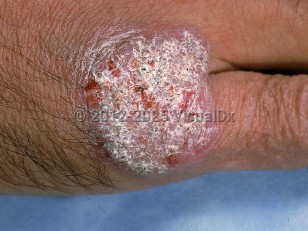Chromoblastomycosis
Alerts and Notices
Important News & Links
Synopsis

Chromoblastomycosis (also known as chromomycosis, Pedroso disease, and Fonsecaea disease) is a subcutaneous fungal infection caused by one of several dematiaceous (pigmented) fungi, most commonly Cladosporium carrionii, Fonsecaea pedrosoi, Fonsecaea compacta, Fonsecaea monophora, Phialophora verrucosa, and Rhinocladiella aquaspersa.
Chromoblastomycosis is officially recognized by the World Health Organization (WHO) as a neglected tropical disease (NTD). It is typically found on the lower extremities of middle-aged men in rural areas of tropical and subtropical climates. While it is found in most tropical countries, increased reporting has been seen in Madagascar, Australia, China, Mexico, Cuba, and Africa. Twenty percent of cases occur in the temperate climate of Europe or the Americas. Rare reports from Canada and the United States exist.
The fungus is found in soil, plants, and decaying wood. Farmers, agricultural workers, and miners usually acquire it after traumatic penetration during occupational exposure. Working in sandals or barefoot is a major risk factor. Splinters and traumatic penetration are common sources of inoculation, occurring about 1-2 months before the development of skin lesions. It is 20 times more common in men than in women due to occupational exposure.
Chromoblastomycosis is a locally progressive disease, usually evolving very slowly over many years without many associated symptoms. Early on, there may be an erythematous papule or a warty plaque. This gradually enlarges if untreated and may become annular, vegetating, or nodular. Lymphatic and cutaneous dissemination have been described. A single case of dissemination to the brain has been reported with Fonsecaea pugnacious, a novel species. Complications may include lymphedema, elephantiasis, ulceration, and secondary bacterial infection, and rarely, transformation to squamous cell carcinoma (SCC).
Chromoblastomycosis is officially recognized by the World Health Organization (WHO) as a neglected tropical disease (NTD). It is typically found on the lower extremities of middle-aged men in rural areas of tropical and subtropical climates. While it is found in most tropical countries, increased reporting has been seen in Madagascar, Australia, China, Mexico, Cuba, and Africa. Twenty percent of cases occur in the temperate climate of Europe or the Americas. Rare reports from Canada and the United States exist.
The fungus is found in soil, plants, and decaying wood. Farmers, agricultural workers, and miners usually acquire it after traumatic penetration during occupational exposure. Working in sandals or barefoot is a major risk factor. Splinters and traumatic penetration are common sources of inoculation, occurring about 1-2 months before the development of skin lesions. It is 20 times more common in men than in women due to occupational exposure.
Chromoblastomycosis is a locally progressive disease, usually evolving very slowly over many years without many associated symptoms. Early on, there may be an erythematous papule or a warty plaque. This gradually enlarges if untreated and may become annular, vegetating, or nodular. Lymphatic and cutaneous dissemination have been described. A single case of dissemination to the brain has been reported with Fonsecaea pugnacious, a novel species. Complications may include lymphedema, elephantiasis, ulceration, and secondary bacterial infection, and rarely, transformation to squamous cell carcinoma (SCC).
Codes
ICD10CM:
B43.0 – Cutaneous chromomycosis
SNOMEDCT:
240765004 – Cutaneous chromoblastomycosis
B43.0 – Cutaneous chromomycosis
SNOMEDCT:
240765004 – Cutaneous chromoblastomycosis
Look For
Subscription Required
Diagnostic Pearls
Subscription Required
Differential Diagnosis & Pitfalls

To perform a comparison, select diagnoses from the classic differential
Subscription Required
Best Tests
Subscription Required
Management Pearls
Subscription Required
Therapy
Subscription Required
References
Subscription Required
Last Reviewed:07/19/2025
Last Updated:07/20/2025
Last Updated:07/20/2025
Chromoblastomycosis

